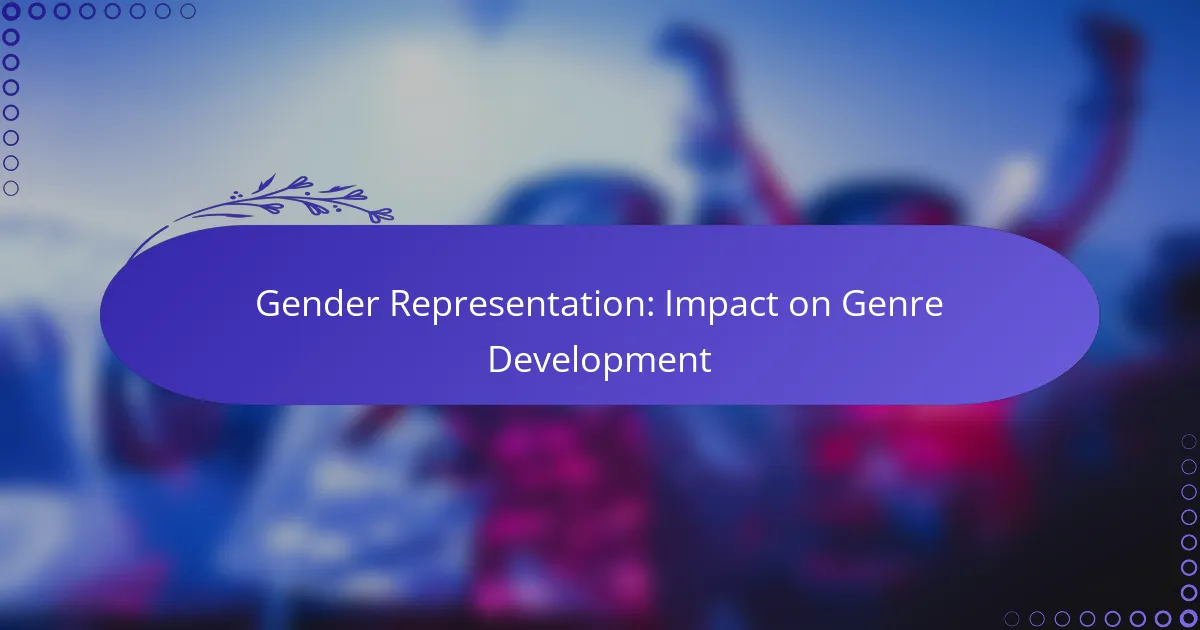Gender representation plays a crucial role in the evolution of various genres in both film and literature, as it introduces a multitude of perspectives and narratives. By incorporating diverse voices, creators can enrich storytelling techniques and character development, ultimately enhancing audience engagement and broadening the scope of cinematic and literary experiences.
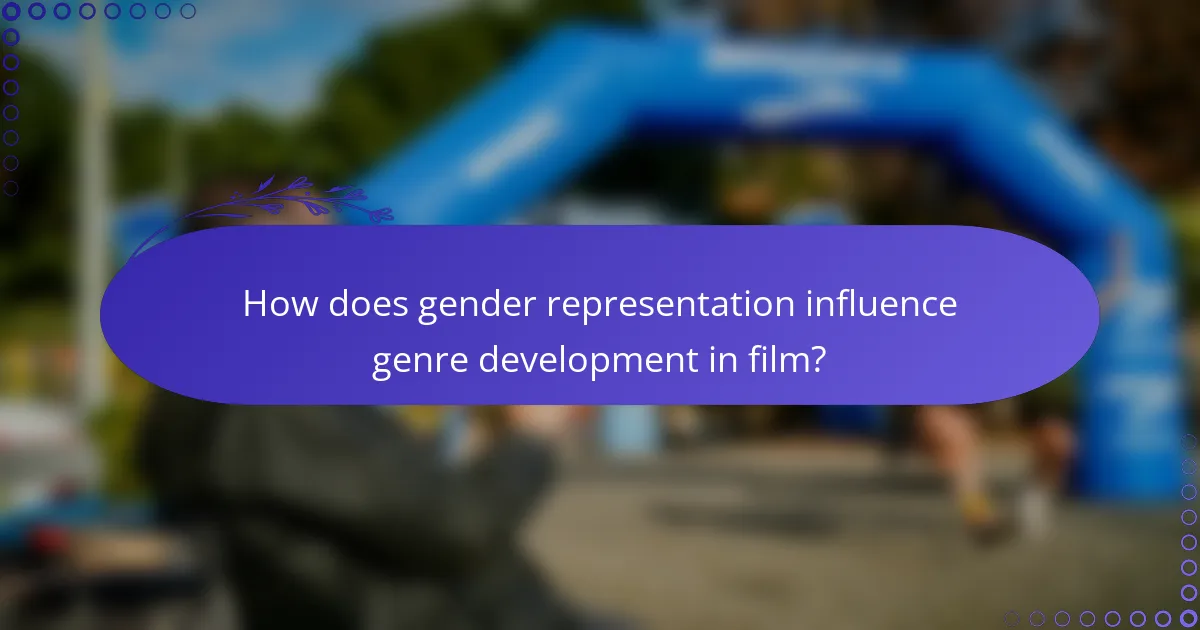
How does gender representation influence genre development in film?
Gender representation significantly impacts genre development in film by introducing diverse perspectives and narratives. This influence shapes storytelling techniques, character arcs, and audience engagement, ultimately leading to richer cinematic experiences.
Increased diversity leads to richer storytelling
When films feature a broader range of gender representations, they often explore themes and experiences that resonate with diverse audiences. This inclusion fosters creativity, allowing filmmakers to experiment with new ideas and narratives that challenge traditional norms.
For instance, films that incorporate female perspectives can delve into topics like empowerment, identity, and relationships in ways that male-centric narratives may overlook. This shift not only enriches the storytelling but also attracts a wider audience base.
Female-led narratives reshape traditional genres
Female-led narratives are transforming established genres by introducing fresh viewpoints and character dynamics. For example, action films with strong female protagonists often subvert expectations, showcasing women in roles that were historically dominated by men.
These narratives can blend genres, such as combining elements of drama with action or horror, creating innovative storytelling forms. As a result, audiences are treated to more complex characters and plots that reflect contemporary societal changes.

What are the key examples of gender representation in literature?
Key examples of gender representation in literature highlight how female authors have shaped various genres, influencing themes, character development, and narrative styles. Their contributions not only challenge traditional norms but also expand the scope of storytelling, providing diverse perspectives that resonate with a wider audience.
Margaret Atwood’s impact on speculative fiction
Margaret Atwood has significantly influenced speculative fiction through her exploration of gender dynamics and societal structures. Her novel “The Handmaid’s Tale” presents a dystopian world where women’s rights are severely restricted, prompting discussions about autonomy and power.
Atwood’s work often blends elements of feminism with speculative elements, encouraging readers to reflect on contemporary issues. By creating complex female characters, she challenges stereotypes and inspires future writers to explore similar themes in their narratives.
Chimamanda Ngozi Adichie’s contributions to contemporary fiction
Chimamanda Ngozi Adichie has made substantial contributions to contemporary fiction by highlighting the experiences of women in Nigeria and beyond. Her novel “Half of a Yellow Sun” delves into the impact of the Nigerian Civil War on women’s lives, showcasing their resilience and strength.
Adichie’s storytelling emphasizes the importance of diverse voices in literature, advocating for gender equality and cultural representation. Her essays and talks further amplify these themes, encouraging both readers and writers to embrace a broader understanding of gender in literature.

How can creators improve gender representation in media?
Creators can enhance gender representation in media by adopting inclusive practices that prioritize diverse voices and perspectives. This involves not only hiring but also fostering environments where underrepresented groups can thrive and contribute meaningfully.
Implementing inclusive hiring practices
Inclusive hiring practices are essential for improving gender representation in media. This can include actively seeking candidates from diverse backgrounds, using gender-neutral language in job postings, and ensuring diverse interview panels. Companies should aim for a balanced representation of genders, ideally reflecting the demographics of their target audience.
To implement these practices effectively, organizations can set specific diversity goals, such as aiming for at least 50% of candidates from underrepresented groups for key positions. Regularly reviewing hiring processes for bias and adjusting them accordingly can also help in achieving these goals.
Creating mentorship programs for underrepresented voices
Mentorship programs can significantly support underrepresented voices in media, providing guidance and resources to navigate the industry. These programs should pair experienced professionals with emerging talent, focusing on skill development and networking opportunities. This fosters a supportive environment where diverse voices can flourish.
To establish effective mentorship initiatives, organizations should consider offering structured programs that include workshops, one-on-one mentoring sessions, and networking events. Encouraging mentors to share their experiences and challenges can also empower mentees, helping them to build confidence and resilience in their careers.

What frameworks exist for analyzing gender representation?
Several frameworks help analyze gender representation, focusing on the roles, visibility, and diversity of genders in various media. These frameworks provide tools to assess how gender dynamics influence storytelling and audience perception.
Bechdel Test for evaluating gender roles
The Bechdel Test is a simple metric used to evaluate gender representation in films and literature. To pass, a work must feature at least two named female characters who talk to each other about something other than a man. This test highlights the presence and agency of women in narratives.
While the Bechdel Test is a useful starting point, it has limitations. It does not measure the depth of female characters or their roles in the story, so a work may pass the test yet still lack meaningful representation. Consider using it alongside other metrics for a more comprehensive analysis.
Representation Index for measuring diversity
The Representation Index quantifies the diversity of gender representation across various media. It assesses the ratio of male to female characters, the complexity of their roles, and the intersectionality of other identities such as race and sexuality. This index provides a broader view of how different genders are portrayed.
When using the Representation Index, aim for a balanced representation that reflects real-world demographics. For instance, if a film features a predominantly male cast, it may score low on the index, indicating a need for more diverse storytelling. Regularly reviewing and updating this index can help creators identify gaps and improve representation over time.
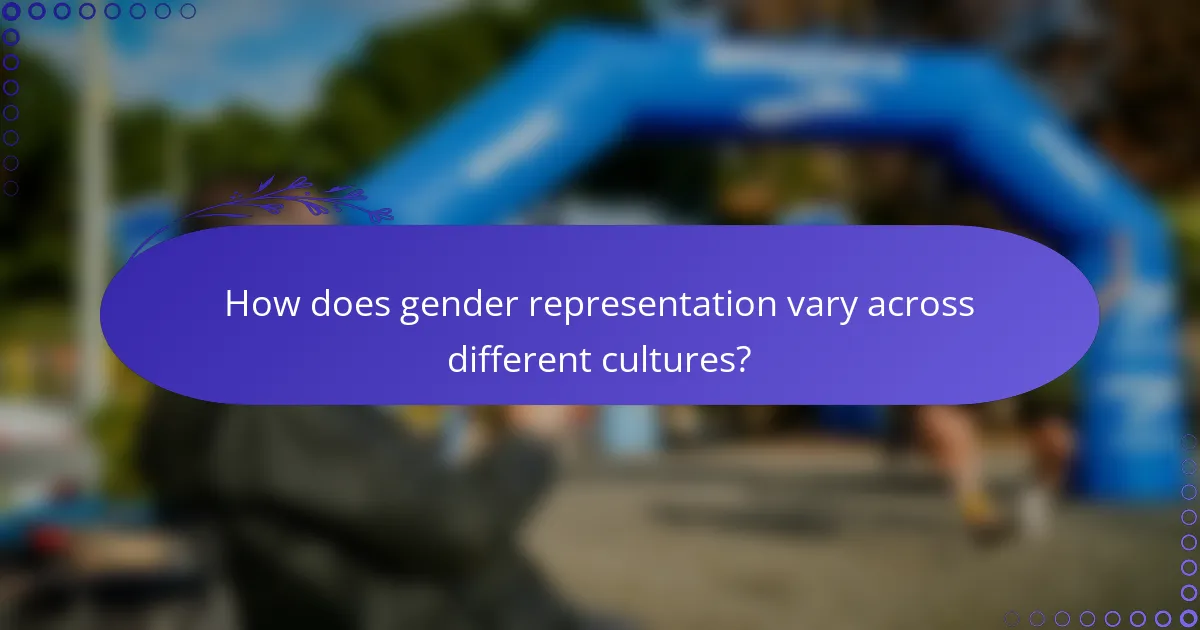
How does gender representation vary across different cultures?
Gender representation differs significantly across cultures, influencing how narratives are constructed and understood. In some societies, traditional roles dominate, while others embrace more progressive portrayals, affecting genre development and audience reception.
Comparative analysis of Western and Eastern narratives
Western narratives often emphasize individualism and personal agency, leading to diverse representations of gender, particularly in genres like science fiction and fantasy. In contrast, Eastern narratives may focus on collectivism and familial roles, which can result in more traditional portrayals of gender, especially in historical dramas and folklore.
For example, Western films frequently feature strong female protagonists who challenge societal norms, while Eastern films might highlight the importance of harmony and duty, reflecting cultural values. This divergence shapes genre conventions and audience expectations in both regions.
Impact of cultural norms on genre evolution
Cultural norms play a crucial role in the evolution of genres, as they dictate acceptable themes and character arcs. In cultures with rigid gender roles, genres may evolve slowly, often reinforcing stereotypes rather than challenging them. Conversely, cultures that promote gender equality tend to see more innovative genre developments.
For instance, the rise of feminist literature in the West has led to new subgenres that explore women’s experiences and perspectives, while in some Eastern cultures, the emergence of contemporary narratives is beginning to reshape traditional genres. Understanding these cultural influences is essential for creators aiming to innovate within their genres.
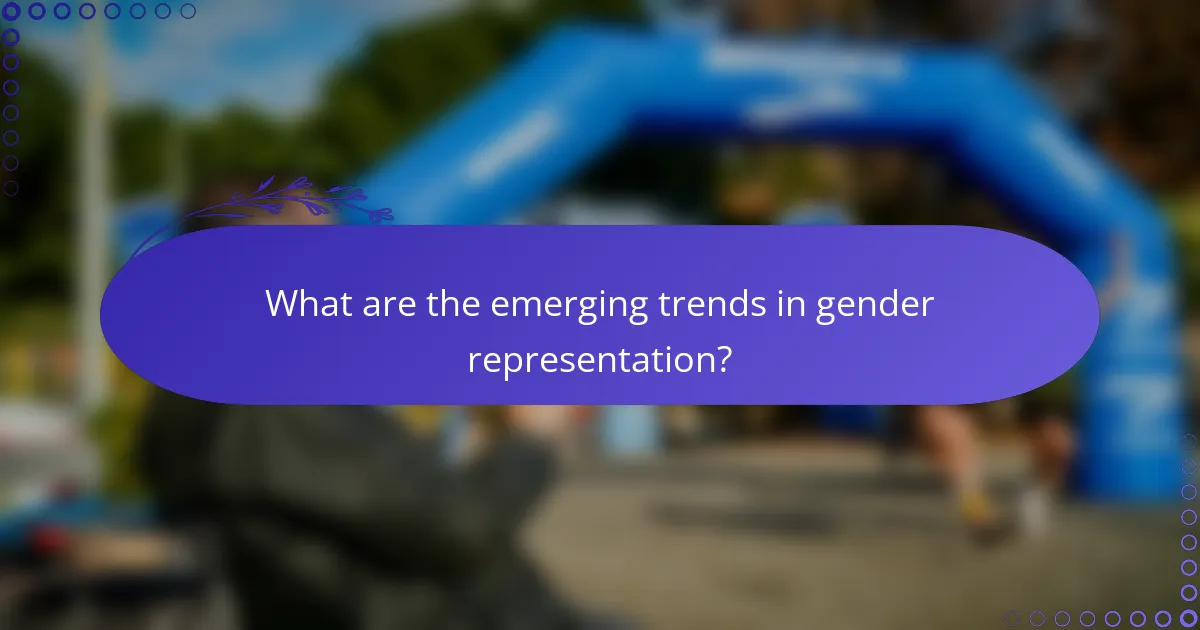
What are the emerging trends in gender representation?
Emerging trends in gender representation highlight a shift towards more inclusive and diverse narratives across various media. These trends reflect a growing recognition of the importance of portraying a wide range of gender identities and experiences, which enhances storytelling and audience engagement.
Rise of intersectional storytelling
Intersectional storytelling focuses on the interconnectedness of various social identities, such as race, gender, and class. This approach allows for richer narratives that reflect the complexities of real-life experiences, moving beyond one-dimensional characters. For example, films and literature that portray women of color or [censured] individuals often explore how these identities intersect, leading to unique challenges and perspectives.
Creators are increasingly encouraged to consider intersectionality in their work, which can lead to broader audience appeal and deeper emotional resonance. Incorporating diverse voices not only enriches the narrative but also fosters a more inclusive environment in the creative industry.
Increased visibility of [censured] characters in mainstream media
The visibility of [censured] characters in mainstream media has significantly increased over recent years, reflecting societal shifts towards acceptance and representation. This trend is evident in television shows, films, and literature that feature [censured] protagonists and storylines, allowing for more authentic portrayals of diverse experiences. For instance, popular series now often include [censured] characters as central figures rather than side roles.
While this visibility is a positive step, it is essential for creators to portray [censured] characters with depth and authenticity, avoiding stereotypes. Audiences are increasingly discerning, and well-rounded characters can foster empathy and understanding, while tokenism can lead to backlash. Ensuring that [censured] narratives are written by individuals within the community can also enhance authenticity and representation.
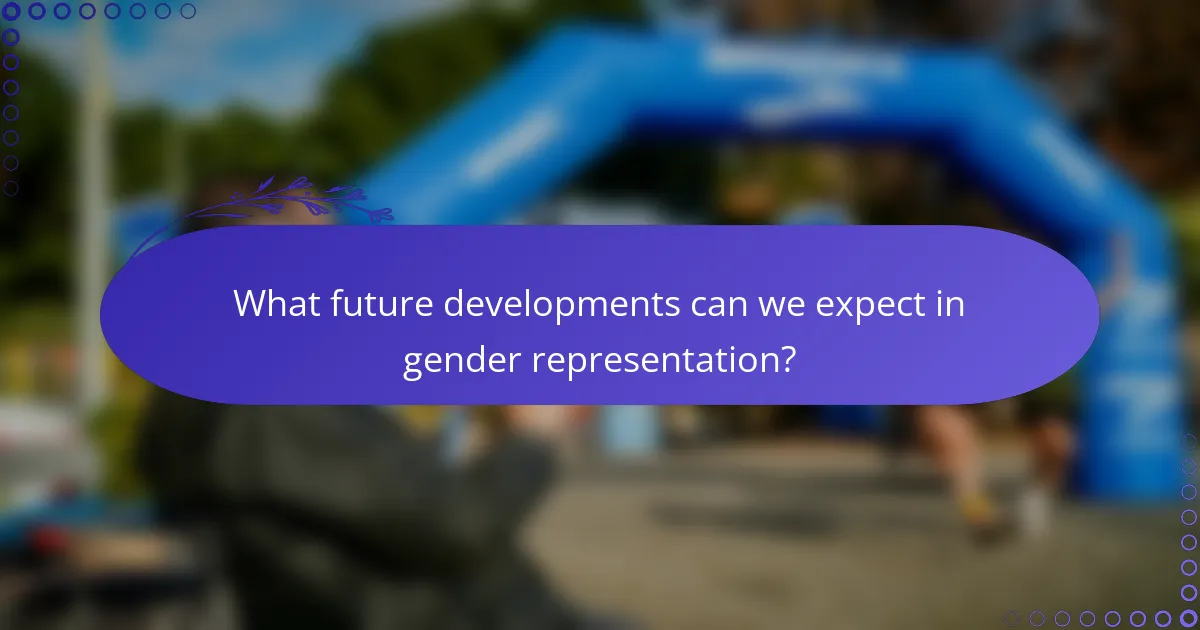
What future developments can we expect in gender representation?
Future developments in gender representation are likely to focus on increased inclusivity and diversity across various genres. As societal norms evolve, creators are expected to embrace broader narratives that reflect a wider range of gender identities and experiences.
Advancements in technology enabling diverse narratives
Technological advancements are playing a crucial role in fostering diverse narratives in media and literature. Tools such as artificial intelligence and data analytics allow creators to analyze audience preferences and tailor content that resonates with various gender perspectives.
For instance, platforms that utilize machine learning can identify gaps in representation and suggest storylines that include underrepresented voices. This not only enhances the richness of narratives but also broadens the audience base, making stories more relatable and engaging.
Moreover, the rise of independent publishing and digital media has lowered barriers for creators, enabling more voices to share their stories. This democratization of content creation encourages a variety of gender representations that were previously marginalized in mainstream media.
